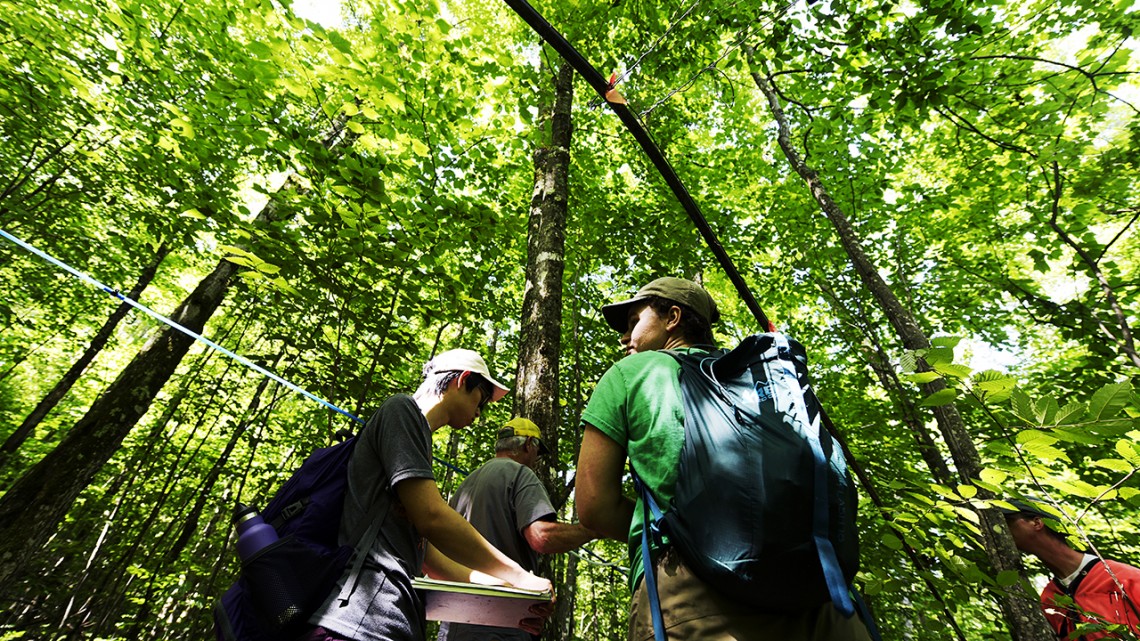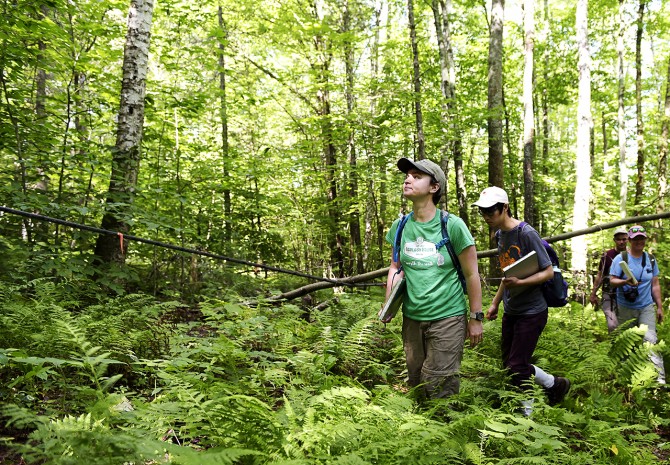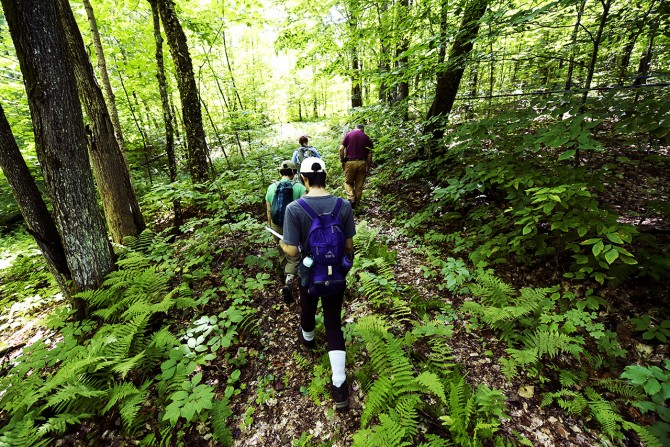
CALS students Alex Ding ’21, left, and Katie Sims ’20, green shirt, work with maple syrup producer Brad Presby, center, and forestry consultant Jon Martin, far right. Ding and Sims participated in the maple seedling project through a Cornell Engaged Undergraduate Research Grant.
Students hunt for maple seedlings in the name of science
By David Freedman
This summer, a small team of citizen scientists – including two students from the College of Agriculture and Life Sciences – bushwhacked their way through dense forest growth and clouds of biting insects.
Their mission: gather scientific data about tree growth that could be key to the long-term health of New Hampshire’s sugar maples.
The two undergraduates – funded by a Cornell Engaged Undergraduate Research Grant – are helping lead the project, which will track the progress of sugar-maple seedlings in four patches of New Hampshire forest over seven years. Their goal is to determine whether enough seedlings are likely to survive to replace the mature trees currently tapped for maple syrup production.
Not only are the two students – Katie Sims ’20 and Alex Ding ’21, both environmental and sustainability sciences majors – doing much of the fieldwork, they’re forging ties to the public along the way. Said Sims: “We’re trying to understand the pathways of information between forest research and the people who see the land in different ways.”
The project was spearheaded by Natalie Cleavitt ’93, a vegetation scientist at Hubbard Brook Experimental Forest in New Hampshire and a CALS graduate. Cleavitt collaborates closely with forest ecologist Tim Fahey, professor of natural resources, who has been studying sugar-maple seedling growth at Hubbard Brook. However, Cleavitt wanted to expand the research into other areas of the state and promote public engagement with the research.
“Science shouldn’t be biased to giving people what they want to hear, but it shouldn’t take place in a vacuum, either,” she said. “We wanted to make this an unusually well-rounded project.”
To do that, Cleavitt brought in the Society for the Protection of New Hampshire Forests – better known as the Forest Society – a statewide land trust that owns 58,000 acres of forest land and promotes public interest in the sustainable use of forests. Then, realizing the project would be a good opportunity for students, Cleavitt worked with Fahey to secure the Engaged Undergraduate grant.
“The grant was a godsend,” she said. “We couldn’t have done this without the students.”
Part of the students’ job was training and overseeing a group of about 20 Forest Society volunteers – mostly retirees, plus a few teachers and local graduate students who had the summer off. The team gathered data alongside Sims and Ding, who were responsible for making sure everyone’s measurements met the project’s scientific standards.
Those measurements included surveying all the trees in the stand, recording the health of 50 seedlings at each site and tagging them. They also observed the general condition of surrounding vegetation and terrain and took soil samples. The measurements will be repeated at the same sites for the next seven years, to get a sense of whether enough seedlings are thriving.
An essential part of the project included meetings with various stakeholders, such as leaders in the maple-syrup industry, timber-company managers, landowners and conservationists. At the meetings, Cleavitt, Sims and Ding explained the goal of the research, and asked the stakeholders about their interests and concerns relating to the health of the seedling population.
“The exchange was really interesting,” said Sims. “Forest management is different than forest ecology research, and we got to see those two pieces come together during the meetings. It forced us to demystify and clarify the science we were doing, and to see things from their point of view.”
The students also presented at the Hubbard Brook annual scientific meeting in July; and in August, they ran a game show-style information session for the public at a science cafe evening run by the Forest Society.
Sims, Ding and Cleavitt all agree that the student participation in the project was a big win for all involved. “I can’t think of how it could have gone better,” Cleavitt said. “It has us thinking about putting together an even bigger project that will also include high school science classes.”
As for the future of the young sugar maple trees, Fahey thinks they will need several more years of data before making predictions about the seedlings’ survival. “But the project has already proved a bright success,” he said, “on the basis of the learning experience of both students and volunteers.”
David H. Freedman is a freelance writer for the College of Agriculture and Life Sciences.
Media Contact
Get Cornell news delivered right to your inbox.
Subscribe


